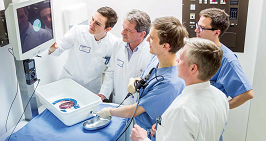Inventive genius helps the bladder and prostate

Intelligent laser systems, near-body sensors for detecting blood in urine, and robots that move independently through the urinary tract: the Urotechnology Section develops new products from initial concept to prototype to market-readiness.
Urinary stones are treated about 750,000 times annually in Germany. Ever more often, the stones are crushed and removed via the ureter using an endoscope. The process itself is very gentle yet effective. But often, minute fragments remain in the renal cavity which can in turn become crystallization nuclei for new deposits. "We didn't want to let ourselves settle for this result," says Dr. Arkadiusz Miernik, head of the Urotechnology Section in the Department of Urology at the Medical Center - University of Freiburg.
Dr. Arkadiusz Miernik, 32-year-old senior physician in the Department of Urology, together with his Freiburg colleague senior physician Dr. Martin Schönthaler and researchers from the Fraunhofer Institute for Manufacturing Technology and Advanced Materials in Bremen, found a completely new approach to solving the problem. When the stone is crushed by laser and the large pieces are removed, a biocompatible, water-resistant adhesive is injected into the renal cavity. This glues together the remaining tiny fragments of stone and forms an elastic gel which can then be removed endoscopically.
Today - just five years after the initial concept - the project is funded with nearly two million Euros by the German Federal Ministry of Education and Research (BMBF), and is almost ready to be used on patients. "If all goes well, the gel could be tested on patients next year," hopes Miernik, who at the end of 2015 became the youngest urologist in Germany with a doctorate degree and for his work received the highest honor of the German Urology Society. "It's like music to my ears, to think through problems and new ideas like these," says the doctor.
FROM CONCEPT TO MARKET-READY PRODUCT
Yet the glue is not a random product but rather a textbook example of how members of the Urotechnology Section - founded at the end of 2014 - work. They are developing new ideas for clinically applicable treatment concepts: for treating kidney stones, prostate cancer and many other diseases. "The section offers doctors a structured framework for research and development. They are supported by us from initial concept through prototype development and up to market launch", explains Professor Dr. Ulrich Wetterauer, Medical Director of the Department of Urology. This translational research has yet another advantage: it allows the Freiburg doctors to actively shape new inventions, instead of just being faced with the final product.
THINK TANK RUNS FULL SPEED
The researchers work on many inventions simultaneously: intelligent laser systems, near-body sensors for detecting blood in urine, even robots that one day should be able to move independently through the urinary tract. They have recently registered four patents and have written numerous invention disclosure reports. The urologists place particularly high hopes in an analysis system that allows doctors to determine the composition of renal stones within a few minutes: if for example the stone contains a lot of calcium oxalate, the patient should avoid sugary soft drinks and instead drink carbonated mineral water and citrus juices. Thus far only specialized laboratories have offered this analysis: the doctor and patient had to wait weeks for results. "Often we see patients following the operation but never again for aftercare. With the new system we could immediately give nutritional recommendations and thus reduce the risk of further stone formation," Miernik explains.
See also:
Back